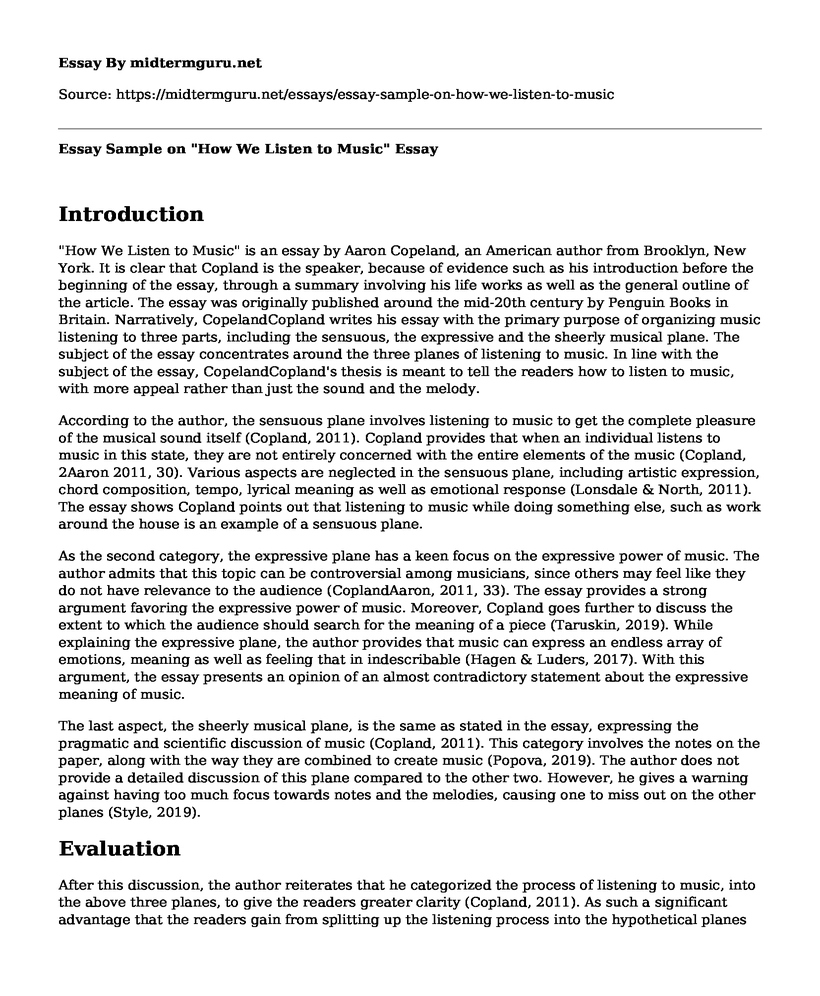Introduction
"How We Listen to Music" is an essay by Aaron Copeland, an American author from Brooklyn, New York. It is clear that Copland is the speaker, because of evidence such as his introduction before the beginning of the essay, through a summary involving his life works as well as the general outline of the article. The essay was originally published around the mid-20th century by Penguin Books in Britain. Narratively, CopelandCopland writes his essay with the primary purpose of organizing music listening to three parts, including the sensuous, the expressive and the sheerly musical plane. The subject of the essay concentrates around the three planes of listening to music. In line with the subject of the essay, CopelandCopland's thesis is meant to tell the readers how to listen to music, with more appeal rather than just the sound and the melody.
According to the author, the sensuous plane involves listening to music to get the complete pleasure of the musical sound itself (Copland, 2011). Copland provides that when an individual listens to music in this state, they are not entirely concerned with the entire elements of the music (Copland, 2Aaron 2011, 30). Various aspects are neglected in the sensuous plane, including artistic expression, chord composition, tempo, lyrical meaning as well as emotional response (Lonsdale & North, 2011). The essay shows Copland points out that listening to music while doing something else, such as work around the house is an example of a sensuous plane.
As the second category, the expressive plane has a keen focus on the expressive power of music. The author admits that this topic can be controversial among musicians, since others may feel like they do not have relevance to the audience (CoplandAaron, 2011, 33). The essay provides a strong argument favoring the expressive power of music. Moreover, Copland goes further to discuss the extent to which the audience should search for the meaning of a piece (Taruskin, 2019). While explaining the expressive plane, the author provides that music can express an endless array of emotions, meaning as well as feeling that in indescribable (Hagen & Luders, 2017). With this argument, the essay presents an opinion of an almost contradictory statement about the expressive meaning of music.
The last aspect, the sheerly musical plane, is the same as stated in the essay, expressing the pragmatic and scientific discussion of music (Copland, 2011). This category involves the notes on the paper, along with the way they are combined to create music (Popova, 2019). The author does not provide a detailed discussion of this plane compared to the other two. However, he gives a warning against having too much focus towards notes and the melodies, causing one to miss out on the other planes (Style, 2019).
Evaluation
After this discussion, the author reiterates that he categorized the process of listening to music, into the above three planes, to give the readers greater clarity (Copland, 2011). As such a significant advantage that the readers gain from splitting up the listening process into the hypothetical planes is the clearer view that people have while they listen to music. Moreover, I think that as an advantage, despite the difficulty of the topic, Copland uses a straightforward language that creates an understanding of the audience. The essay, however, has a significant weakness where the readers that are not familiar with classical music might not get a full understanding of the comparison between different composers as well as the pieces discussed in the essay. T Moreover, the third plane; sheerly musical may be lost upon translation.
References
Copland, A.Aaron, C. (2011). "How We Listen to Music." Mercury Reader. Ed. Anita Nordbrock. New York: Pearson, 2011. . 28-34. Print.
Hagen, A. N., & Luders, M. (2017). Social streaming? Navigating music as personal and social. Convergence, 23(6), 643-659: https://www.duo.uio.no/bitstream/handle/10852/58626/1/Social-Streaming-Navigating-music-as-per.pdf.
Lonsdale, A. J., & North, A. C. (2011). Why do we listen to music? A uses and gratifications analysis. British Journal of Psychology, 102(1), 108-134: https://s3.amazonaws.com/academia.edu.documents/50332137/000712610x50683120161115-64751mpt16c.pdf?AWSAccessKeyId=AKIAIWOWYYGZ2Y53UL3A&Expires=1559363454&Signature=Ba9GwlFNh641POHXYw6%2FpvS%2FiOU%3D&response-content disposition=inline%3B%20filename%3DWhy_do_we_listen_to_music_A_uses_and_gra.pdf.
Popova, M. (2019). How to Listen to Music: A Vintage Guide to the 7 Essential Skills. Retrieved from https://www.brainpickings.org/2012/04/12/elliott-schwartz-music-ways-of-listening/
Hagen, A. N., & Luders, M. (2017). Social streaming? Navigating music as personal and social. Convergence, 23(6), 643-659. Style, P. (2019). "How We Listen to Music"- Aaron Copland - Pamela Style. Retrieved from https://sites.google.com/a/msu.edu/pamela-style/reading-responses/-how-we-listen-to-music---aaron-copland
Taruskin, R. (2019). Aaron Copland: How We Listen. Retrieved from http://kabray.tripod.com/mypersonalsite/id2.html
Popova, M. (2019). How to Listen to Music: A Vintage Guide to the 7 Essential Skills. Retrieved from https://www.brainpickings.org/2012/04/12/elliott-schwartz-music-ways-of-listening/
Cite this page
Essay Sample on "How We Listen to Music". (2023, Jan 16). Retrieved from https://midtermguru.com/essays/essay-sample-on-how-we-listen-to-music
If you are the original author of this essay and no longer wish to have it published on the midtermguru.com website, please click below to request its removal:
- Review of Roanoke the Abandoned Colony - Paper Example
- "Abortion" by Sexton, "New World" by Momady, and "Mercy Street" by Gabriel - Poetry Analysis Essay
- Winston Smith, Hero or Not? - Essay Sample
- American Civil War: A Series of Events That Led to War - Essay Sample
- Poor Living Conditions Impact Academic Performance of Students - Essay Sample
- Cultural Diversity: Religion - Essay Sample
- A Horrific War: The American Civil War (1861-1865) - Research Paper







